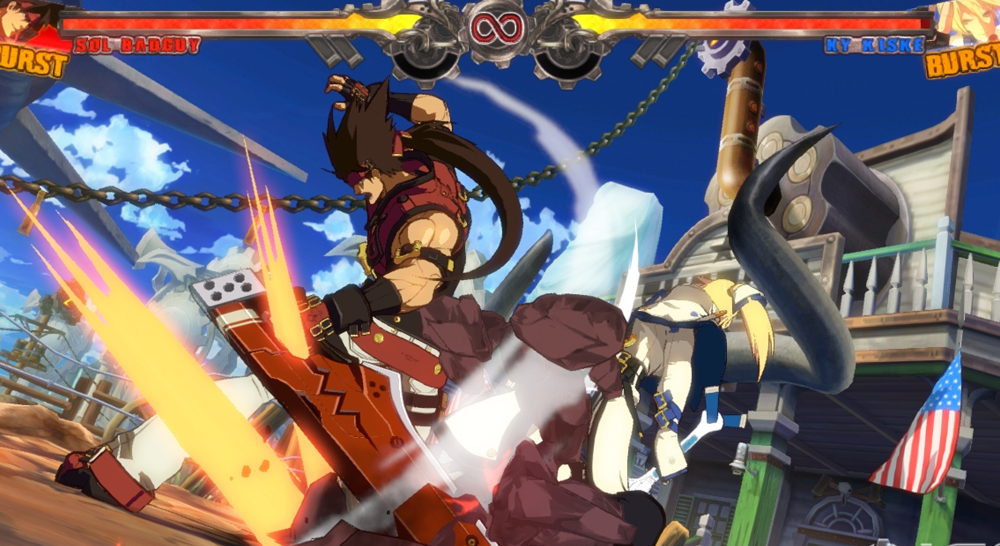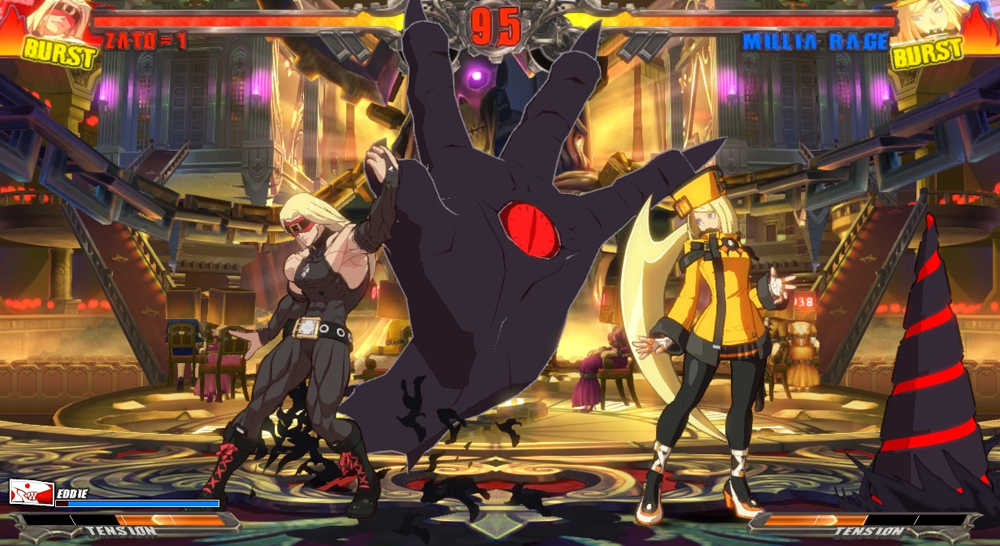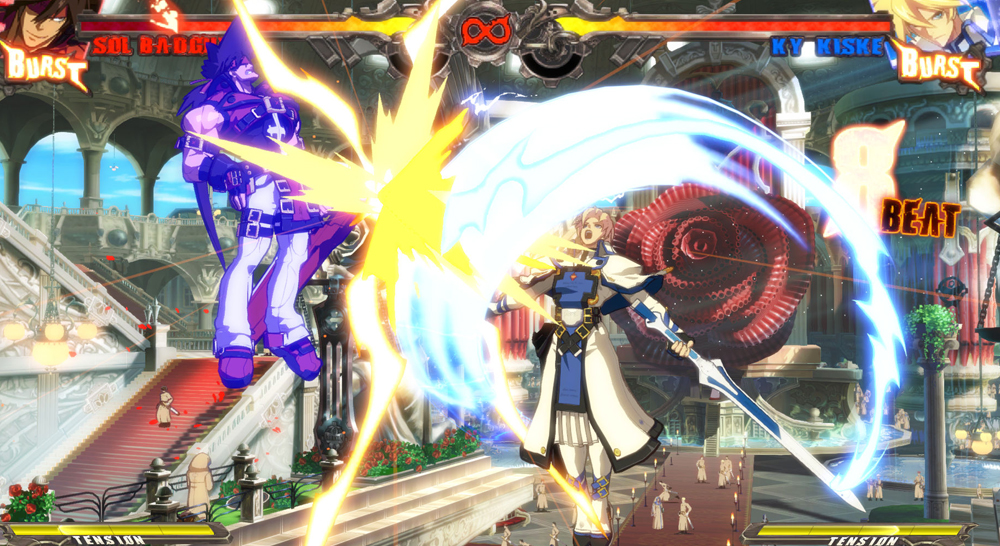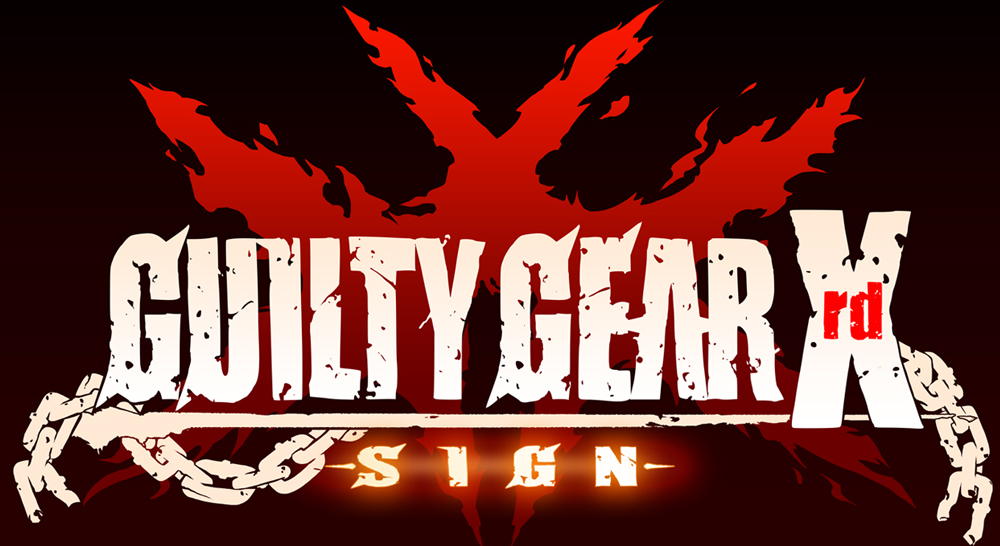Gameplay
Each member of Guilty Gear Xrd’s roster is wholly distinct in their core mechanics and the way they are played. While Sol and Ky feel vaguely like Ken and Ryu, it is here that familiar ground begins to fade away, replaced by sheer insanity in the form of projectiles from all angles, teleporting minions, and levitating sword traps. Warriors like Zato-1 can use his ally, Eddie, to attack an enemy from both sides, or to feign an offensive maneuver. Chipp can use his speed and his ability to teleport to confuse his opponents and break through their defenses. There’s a character to suit every style, and no two feel alike.
If you’re new to games like Guilty Gear, Xrd is packed with loads of helpful tutorials and challenge modes to ease you into the action. The tutorials are impressive in their depth, covering all the basics before detailing advanced concepts like mix-ups, zoning and space control, and more. The challenge modes introduce each character’s unique special moves and teach a broad mix of combos, covering a range of options including standard bread and butter combos, anti-air punishes, and counter-hit combos. These instructional modes teach not only entry-level mechanics unique to Guilty Gear Xrd, they also impart knowledge of fundamental concepts present in most two-dimensional fighting games. With them, Guilty Gear Xrd does an admirable job of making it all accessible not only for those of us making the jump from other fighting games, but for those checking the genre out for the very first time.
 Rest assured, however, that despite its commendable approach to newbies, Guilty Gear Xrd is a game whose learning curve ramps from gentle slope to sheer brick wall seemingly in the blink of an eye. This is an incredibly complex and technical battleground populated by some of the most imaginative and downright bizarre protagonists in any game, anywhere. It will push your dexterity and reactions, and reward your patience. Memorizing basic combos opens the door to learn exponentially more difficult ones incorporating mid-air dashes, double jumps, counter hits, and more. Learning new ways to unleash the offensive potential of my character left me with a sense of satisfaction; taking that knowledge into an actual match and executing it correctly imparted a sense of pride.
Rest assured, however, that despite its commendable approach to newbies, Guilty Gear Xrd is a game whose learning curve ramps from gentle slope to sheer brick wall seemingly in the blink of an eye. This is an incredibly complex and technical battleground populated by some of the most imaginative and downright bizarre protagonists in any game, anywhere. It will push your dexterity and reactions, and reward your patience. Memorizing basic combos opens the door to learn exponentially more difficult ones incorporating mid-air dashes, double jumps, counter hits, and more. Learning new ways to unleash the offensive potential of my character left me with a sense of satisfaction; taking that knowledge into an actual match and executing it correctly imparted a sense of pride.
While Xrd will feel immediately familiar to long-time Guilty Gear fans, a surprising amount has changed. The Roman Cancel system returns in expanded form, allowing players to cancel out of virtually any attack animation, whether it made contact with the opponent or not – a first for the Guilty Gear series. Dust Attacks, which launch your target far into the air to be juggled, have also been expanded upon, with Xrd implementing a dashing follow-up which opens all new combo options to utilize against enemies in the corner. Then there’s the Blitz Shield, a powerful new defensive tool that can quickly reverse the momentum of a match, giving you breathing room against an especially aggressive opponent. Xrd has enough new features and mechanics to feel like a true sequel, while excellently retaining many of the classic elements that impart the good old feeling of a Guilty Gear game.
 The very same goes for Xrd’s look. In combat, colors abound, with the three-dimensional combatants cell-shaded so as to replicate the series’ traditional two-dimensional sprites. Battles unfold amidst gorgeously-rendered backgrounds. Each of the characters sport hundreds of unique animations that breathe life into both old favorites and new challengers. The fights are amplified by the heavy metal soundtrack, another Guilty Gear convention done justice.
The very same goes for Xrd’s look. In combat, colors abound, with the three-dimensional combatants cell-shaded so as to replicate the series’ traditional two-dimensional sprites. Battles unfold amidst gorgeously-rendered backgrounds. Each of the characters sport hundreds of unique animations that breathe life into both old favorites and new challengers. The fights are amplified by the heavy metal soundtrack, another Guilty Gear convention done justice.
Guilty Gear Xrd’s multi-player modes are the standard fare for fighting games, at this point. You can engage in duels with your friends from the couch, or you can take your skills online to challenge players from around the world in Player Matches or Ranked Matches. The addition of cross-play between PS3 and PS4 is a welcome addition, but Xrd’s online matchmaking lobbies are arranged oddly. The somewhat un-intuitive interface sometimes makes it difficult to find opponents quickly. In addition, Xrd’s netcode can make it difficult to connect to the matches you do finally manage to sift out, and once connected, even steady connections can suffer from stuttering and other latency issues.


